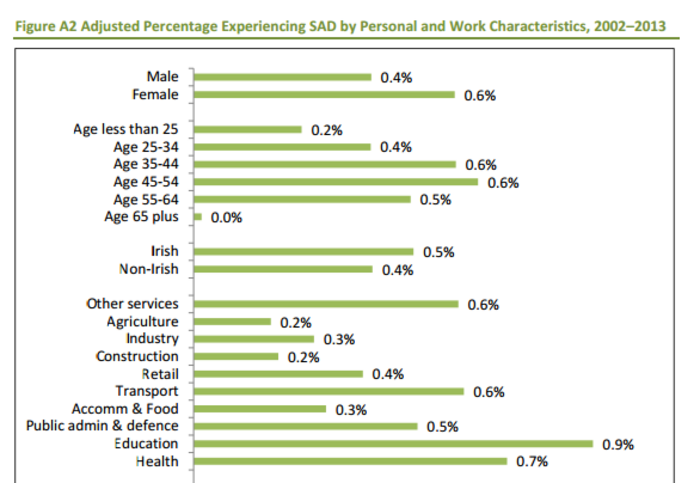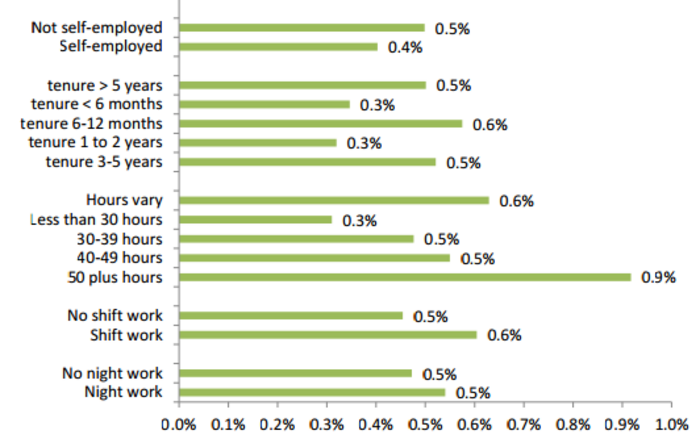Ireland's educators have the highest rates of work-related depression
A new study also found fixing the ‘long-hours culture’ in workplaces could help the issue.
PEOPLE WORKING IN the Irish education sector are particularly at risk of developing work-related depression, a new study has found.
According to the report from think-tank the ESRI, in Ireland the risk of SAD illness is highest for workers in the education sector.
In 2013, an estimated 55,000 workers in Ireland suffered from a work-related illness, resulting in the loss of 790,000 days of work, with SAD being the most common cause.
SAD is work-related stress, anxiety and depression and accounts for half of all work-related illnesses.
The report identified the risk factors associated with SAD and work-related musculoskeletal disorders (MSD), an umbrella term for ailments affecting parts of the body used for movement.
Women and education risks
Using data for the years 2002-2013, the research found:
- Women have a higher risk of SAD illnesses, with 5.8 out of every 1,000 female workers experiencing this type of illness, compared to 4 per 1,000 men
- Workers aged 35 to 54 are most likely to experience SAD
- The risk of SAD illness is highest for workers in the education sector, followed by those in health, public administration, transport and ‘other services’, which includes finance and communications
- Workers in the agriculture, construction and industries have the lowest risk of SAD with fewer than 3 illnesses per 1,000 workers

The study also found that there is a greater risk of SAD illness for those working longer hours. People working over 50 hours are three times more likely to experience SAD than those working fewer than 30 hours.
 SAD occurrences by personal and work characteristics 2002-2013
SAD occurrences by personal and work characteristics 2002-2013
Musculoskeletal disorders
When it came to the risks for MSD, the research found no gender-related differences after factors such as sector and work conditions, such as hours, were accounted for. It also found:
- Workers aged 35 to 64 years have the highest risk of MSD and are 2.5 times more likely to experience such illnesses than workers under 25
- The risk of MSD is greatest for workers in the construction, agriculture and health services sectors. The risk is lowest for workers in the education sector and in ‘other services’
- MSDs are not strongly linked to working hours and the risk of was lower in years with a high health and safety inspection rate
Long-hours culture
The ESRI said that the high proportion of SAD cases among work-related illnesses “suggests that a greater awareness of mental health issues is required”.
“Employers find it difficult to assess and manage mental health risks, therefore further information and supports, such as stress-audit tools may prove useful,” it said.
“There is a necessity to monitor work-related illnesses in sectors with greater risks of SAD and MSD and in organisations which operate shift work and night work.
“Addressing the ‘long-hours culture’ in workplaces is likely to reduce SAD.”
The research also noted that older workers are most at risk of MSD, and added that it is “important to consider measures that minimise the risks of MSD and assist those experiencing such illnesses”.
Productivity and social costs
ESRI associate research professor Helen Russell, who wrote the report, said the research findings “point to a need for targeted measures to address work-related illnesses”.
“(This is) not only to assist workers experiencing difficulties, but also to tackle the issues of lost productivity, and the associated costs for health care and social protection,” she said.
“As the rate of work-related illness increased during the boom years, it is especially important to consider implementing such measures as the economic recovery accelerates.”






